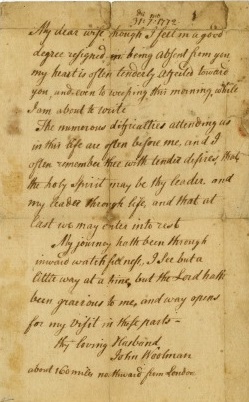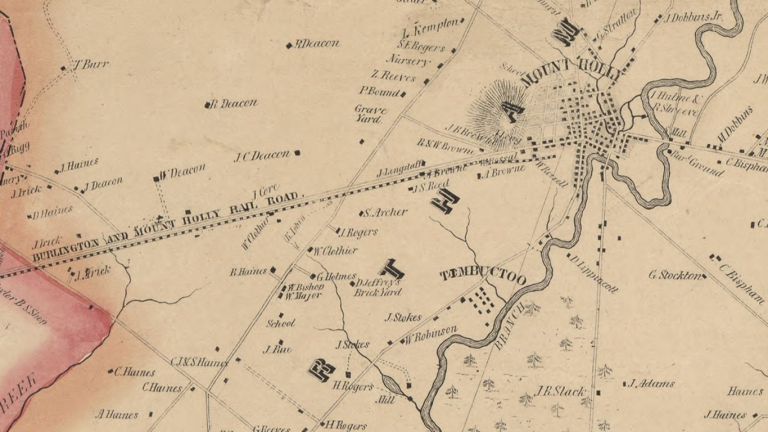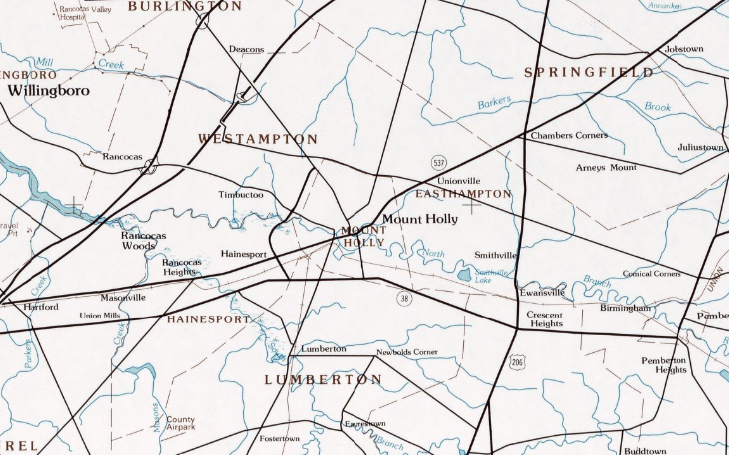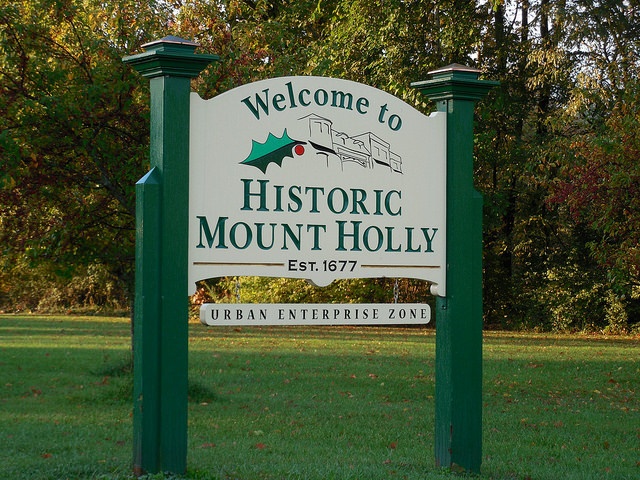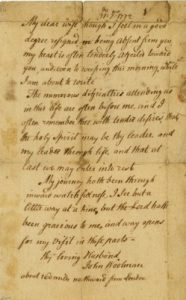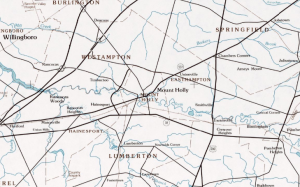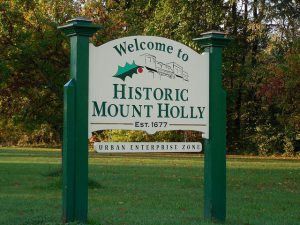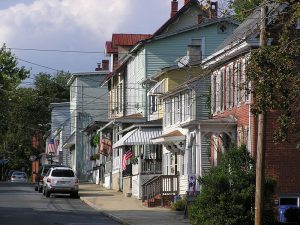Mount Holly Township, New Jersey
By Vibiana Bowman Cvetkovic | County Seat
Essay
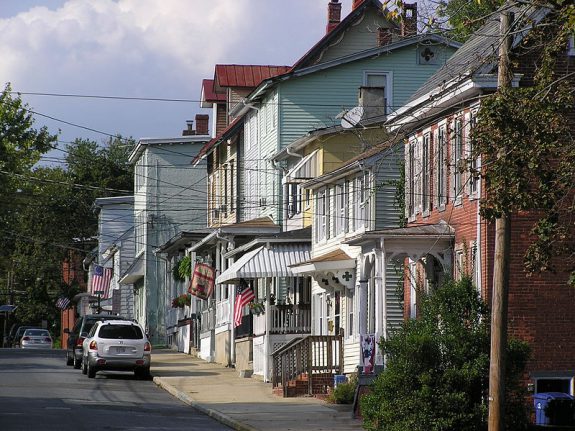
Mount Holly, New Jersey, established by Quakers in 1677 and known variously in its early history as Northampton and Bridgetown, became the county seat for Burlington County through an act of legislation in 1793. Three years later the Burlington County Court House, similar in style to Philadelphia’s Congress Hall, opened to serve as the official county court facility, a position it held until a new building assumed those responsibilities in 1959. Officially renamed in 1931 as Mount Holly, the name that it had been commonly known as since the Revolutionary War, the town owed its position as county seat to its central location twenty-four miles east of Philadelphia and its agricultural and manufacturing prominence. Over time, Mount Holly played a significant, and sometimes controversial, role in the Philadelphia region, even serving as a temporary capital for New Jersey during the Revolutionary War.
Mount Holly was originally home to the Lenni Lenape people, who lived in the area for over ten thousand years—long before the arrival of the Europeans in the seventeenth century. When British settlers arrived, the Lenape not only traded with them but also taught the settlers the skills necessary for frontier survival. However, these interactions brought devastation to the Lenape through diseases like smallpox and cholera, to which the Native Americans had no immunity. The indigenous people died in shockingly large numbers, so much so that by the mid-1700s only a few enclaves of the Lenape remained.
The first white, English-speaking person credited with settling the area was Walter Reeves (?-1698), who arrived in 1677 to establish a plantation along the Rancocas Creek. As it flourished, it attracted other settlers who established grist and sawmills in support of the predominantly farm community, which was incorporated in 1688. The first gristmill in Mount Holly was built in 1723, and a sawmill situated on the Rancocas was built in the early 1700s. In the eighteenth century, the Rancocas Creek was dammed and water redirected for use by the farms and mills, an area later preserved as a recreational facility known as Mill Dam Park.
Battle of Trenton
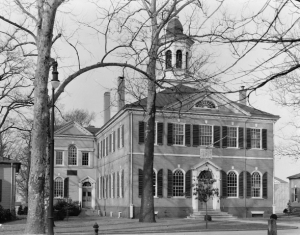
Mount Holly played a pivotal role in the Battle of Trenton during the Revolutionary War. The Battle of Iron Works Hill, also known as the battle of Mount Holly, aided General George Washington (1732-99) in his 1776 assault on Trenton by diverting a large number of Hessian troops to rout forces at Mount Holly. Over two days, December 22 and 23, 1776, a small American force of six hundred militiamen under Colonel Samuel Griffin (1746-1810) engaged some two thousand British regulars and Hessians commanded by Colonel Carl von Donop (1732-77).
In addition to the indigenous people and the European settlers, people of color played important roles in developing the region. The African American presence in New Jersey, including the area that encompassed Mount Holly, extended back at least to the late seventeenth century, when slavery served as a source of labor for agriculture and industry. That practice continued until 1804, when the New Jersey legislature passed “An Act for the Gradual Abolition of Slavery.” Although this law freed children of enslaved parents when those children reached the age of majority, it did not emancipate those currently enslaved and it permitted the practice of “apprentice for life” until 1865. Members of Mount Holly’s African American and Quaker communities participated actively in the antebellum abolition movement, and Mount Holly became one of the original stops on the Underground Railroad. The town’s historic village of Timbuctoo, a community of free African Americans founded in 1820, was such a haven for escaping slaves using this network.
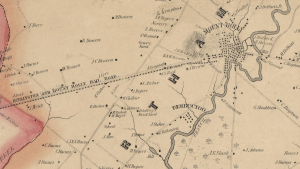
Mount Holly’s proximity to the transportation hubs of Philadelphia and Camden, as well as its agricultural, canning, manufacturing, and textile industries, contributed to its economic success as a regional force by the onset of the nineteenth century. Among its manufacturing endeavors were Semple’s Cotton Mill (founded in 1856) and the Ridson Foundry (1847). Travel from Mount Holly to Philadelphia and Camden was made possible by ferries, stagecoach, and a rail service that started in 1867. Mount Holly’s town center hosted many small businesses and retail stores as well as newspaper offices.
In the twentieth century Mount Holly’s economy received a boost from the Camp Dix army base, established in 1917 as a staging and training center for World War I and located approximately ten miles from the township. Construction of the camp involved recruiting and hiring eleven thousand workers from the area. During the 1930s the camp served as a base for members of the Civilian Conservation Corps, and in 1939 the army made it a permanent military base, Fort Dix. In 2009 the Department of Defense merged Fort Dix with McGuire Air Force base and the Lakehurst Naval Air Engineering Station to create McGuire-Dix-Lakehurst, the only tri-service joint base in the country. In 1994, Fort Dix added a low-security federal correctional institution housing over four thousand inmates to its primary mission as an induction center.
Twentieth-Century Economic Shifts
As in Philadelphia and Camden, to which Mount Holly’s economy was closely tied, the latter part of the twentieth century became a period of economic decline. National trends of mills, factories, and food-processing plants relocating to less unionized states or overseas meant a loss of blue-collar and middle-class jobs and residents. After reaching a high of 13,271 residents in 1960, the town’s population fell to 9,536 in 2010. Additionally, the construction of nearby shopping centers and malls, notably the Cherry Hill Mall (which opened in 1961) and the Moorestown Mall (1963) changed consumer-buying habits to the point that many small shops and family-owned businesses that had dominated the commercial landscape of downtown Mount Holly closed.
As part of a redevelopment effort, in the early twenty-first century the township designated the 320-acre Mount Holly Gardens development for demolition and reconstruction. Erected in the mid-1950s to accommodate military families at Fort Dix and McGuire at affordable prices, the community consisted of 379 garden-style apartments. The development had been a boon at a time when area housing was in demand, but problems ensued after the builder filed for bankruptcy and the project fell first into the control of a New York City real estate company and subsequently to a patchwork of absentee owners. Despite the town’s periodic efforts to enforce building codes, physical and social conditions deteriorated. By 2002, when Mount Holly authorized the project’s demolition, its affordability had attracted a mixture of lower-income owners and renters, the majority of whom were Black and Latino. Contesting the town’s effort to relocate them, the Gardens’ remaining residents sued, taking their case all the way to the U.S. Supreme Court. Facing ever-mounting legal costs, Mount Holly settled the case in 2013 before the court verdict, agreeing to include units to accommodate the plaintiff’s needs in the new construction, a neighborhood called Parker Green Homes.
Less contentious was Mount Holly’s promotion of investment opportunities created after the state designated it as an Urban Enterprise Zone in 1995. Using the tax incentives available through this program, Mount Holly sought to capitalize on accessibility to Philadelphia, its historic assets, and a revitalized Main Street shopping district to draw retail dollars as well as to reestablish itself as a thriving residential community.
Vibiana Bowman Cvetkovic is a Reference Librarian at the Paul Robeson Library. She is a Ph.D. candidate in the Childhood Studies program at Rutgers University, Camden, New Jersey. Cvetkovic’s area of research and writing include children and media, intellectual ethics, and American popular culture. She is the coeditor of Fleeting Image: Portrayals of Children in Popular Culture (Lexington, 2013). (Author information current at time of publication.)
Copyright 2017, Rutgers University
Gallery
Backgrounders
Connecting Headlines with History
Links
- Township of Mount Holly, New Jersey
- Historic Images of New Jersey - Mount Holly (West Jersey History Project)
- A Brief History of Mount Holly (West Jersey History Project)
- The Nanticoke Lenni-Lenape: An American Indian Tribe
- Revolutionary War Sites in Mount Holly, New Jersey (Revolutionary War New Jersey)
- Slavery in New Jersey (Slavery in the North)
- Timbuctoo, New Jersey
- Business Map of Bristol, Bordentown, Burlington, and Mount Holly, 1870 (Library of Congress)
- Dodging Bulls and Gunshots on New Jersey's Nineteenth-Century 'Bicycle Railroad' (CityLab, 2012)
- Mount Holly v. Mount Holly Gardens Citizens in Action Inc. (SCOTUSblog)
- The Mount Holly Gardens and the Supreme Court (SCOTUSblog On Camera via YouTube)
- Unanimous Vote Settles 10-Year Fight in Mount Holly (NJTV via YouTube, November 14, 2013)
- Don's Barber Shop, Mount Holly, New Jersey (YouTube)
